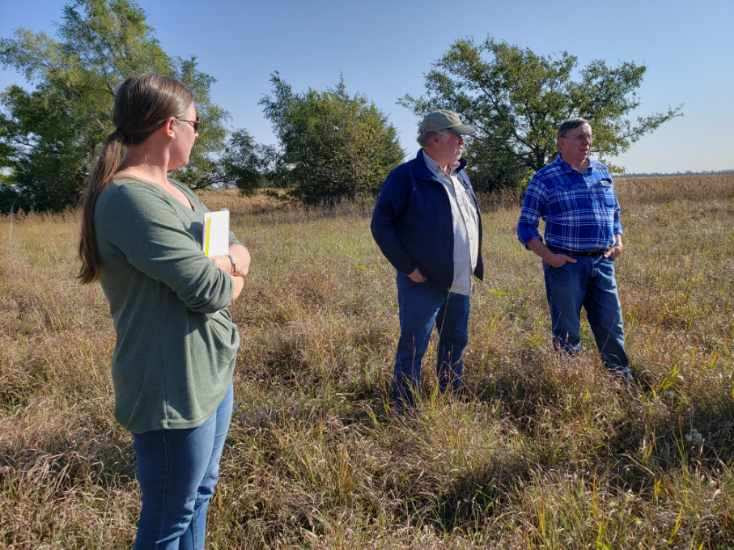By Joanne VanCoevern, Santa Fe Trail Association Manager

Jill Jensen, Aaron Mahr, and George Elmore at Sharpe’s Ruts, a potential High Potential Site and Segment. Courtesy of Joanne VanCoevern.
The National Trails System Act (Act), originally passed in 1968, requires that National Historic Trails identify High Potential Sites and Segments (HPSS). While the Act states that “high potential historic sites” means those historic sites related to the route, or are in close proximity to the route and provide the opportunity to interpret the historical significance of the trail during the period of its major use, and that “high potential route segments” should afford high quality recreation experience, have greater than average scenic value, or provide the opportunity to vicariously share the experience of the original user, no specifics are laid out to make those evaluations.
The Santa Fe Trail was designated as a National Historic Trail in 1987 and in 1989, the Draft Comprehensive Management and Use Plan and Environmental Assessment were distributed to the public, governmental agencies, organizations, and individuals. A draft Map Supplement was also made available for review and comment. Included in that document was a list of HPSS. Because almost 30 years have passed since the document was published, and additional research has identified additional HPSS, the National Trails Office, Santa Fe, approached the Santa Fe Trail Association (SFTA) in 2019 about assisting with beta testing newly developed guidelines for evaluation of Santa Fe Trail related sites and/or segments that might qualify for the inclusion to the listing of “High Potential Sites and Segments.” After reviewing the “Guide” and “Evaluation Sheets” developed by the National Trails Office, volunteers from the SFTA and staff from the National Trails Office, Santa Fe conducted visits to several sites being considered for nomination to the HPSS listing.
On-site visits have included:
Buckner, MO – Fire Prairie Creek Crossing; Kansas City, MO – Hart Grove Campsite (three trails corridor park); Allen, KS – 142 mile bridge; Council Grove, KS – Rock Creek Crossing; Tampa KS – Muddy Creek Crossing; Durham, KS – Donahue Ruts; Durham, KS – French Franks; Galva, KS – Turkey Creek Crossing; Windom, KS – Fry’s Ruts; Chase, KS – Sharpe Ruts; Fort Dodge, KS – Coon Creek Crossing; Dodge City, KS – Chilton Monument/swales; Lamar, CO – John Martin Reservoir; La Junta, CO — Sierra Vista Overlook; La Junta, CO – Timpas Creek; and Raton, NM – NRA Whittington Center.
Using a score sheet, volunteers and staff rated the various “potential site” locations for documentation of location, historical significance, interpretation opportunity, visual similarity to historical landscape, and inappropriate non-visual (smell, sound, etc.) intrusions, and visible historic remnants. Consideration for scoring for “potential segments” included confidence of location, recreational experiences, vicarious experiences, visual similarity and non visual intrusions. The final tally of the score sheets will then be used to determine if a site/segment qualifies to be added to the list of “High Potential Sites and Segments” for the Santa Fe National Historic Trail.
Learn more about the Santa Fe Trail Association at www.santafetrail.org